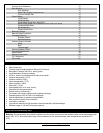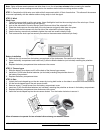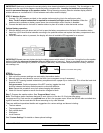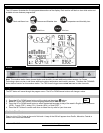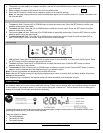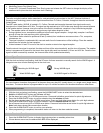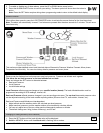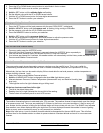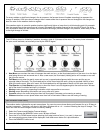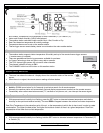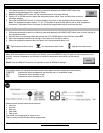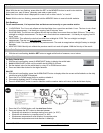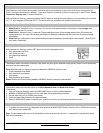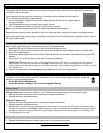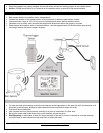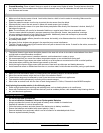
Model: WS-1517 www.lacrossetechnology.com/support 11
For every sudden or significant change in the air pressure, the forecast icons will update accordingly to represent the
change in weather. If the icons do not change, then it means either the air pressure has not changed or the change has
been too slow for the weather station to register.
If the weather station is moved to another location significantly higher or lower than its initial standing point (for example:
from the ground floor to the upper floors of a house), disregard the weather forecast for the next 48-60 hours. By doing
this, the weather station will not mistake the new location as being a possible change in air pressure, when really it is due
to the slight change of altitude.
Moon Phase
The LCD Moon phase is divided by 6 sections, showing a total of 12 phases of the moon. The moon phase is based on
the year, month and date, set manually or set by the WWVB signal.
New Moon occurs when the moon is between the earth and sun, so the illuminated portion of the moon is on the back
side facing the sun and we cannot see it. After a new moon, the illuminated (visible) portion will increase or wax until
the full moon occurs.
Full Moon occurs when the earth, moon and sun are in approximate alignment with the moon and the sun on
opposite sides of the earth. The illuminated portion of the moon faces the earth, giving us complete visibility of one
side of the entire moon. After a full moon, the illuminated portion will decrease or wane until the new moon occurs.
First Quarter and Last Quarter moons occur when the moon is at a 90 degree angle to the earth and sun. We see
half of the moon illuminated and half is in shadow.
Waxing means growing or expanding illumination which occurs after a new moon.
Waning means decreasing illumination and occurs after a full moon.
Crescent refers to the moon being less than half illuminated. Crescents can be waning or waxing.
Gibbous describes a moon phase when more than half is illuminated. Gibbous can be waxing or waning.
View the Moon Phase History
The weather station indicates the current moon phase. You can view moon phase history and forecast for up to 39 days in
one day increments. The history will show in the History Window with a + or – number indicating the days of change. The
moon icon itself will also change to match the history reading.
1. Select the Pressure and Weather Forecast display.
2. Press and release the MEMORY button, and + 0 days will flash.
3. Press the UP or DOWN arrow buttons selecting from today’s date a future (+) or past (-) days and
the corresponding moon phase will be displayed. Hold either arrow button for a quick advance.
4. Press the MEMORY button to exit



